Best Surgical Blades
There are many types of surgical blades, but they all have one thing in common—they all need to be sharp.
There are many types of surgical blades, each manufactured for a specific procedure or surgery. Some are smaller than others.
You should review your inventory before making new surgical blade purchases. These are some things you should consider before making a decision.

You will need to look at the specifications for the blades you buy and also have to consider how many blades you need, and how many you will use at one time. You should make sure that you get the right type of blades.
It is best to order several different sizes so that you don’t have to worry about whether you have enough blades when you need them. You should also make sure that you buy blades that are durable and that can stand up to the wear and tear of surgical procedures. There are many things to consider, so don’t rush into making your purchases. Review your inventory and make sure that you have everything you need. Then you will know that you have the right type of blades.
Your blades are going to get dull, so it is important to keep a good supply on hand. To avoid having to buy extra blades, it is best to get a package deal from the same company that made your last set. Also, it is always better to buy a package deal of blades rather than buying single items at a later date. This will help you save money.
Surgical Blades – which ones are the best?
There are many different styles of blades available, so you can find a style that is comfortable for you. Some people find that the long blades work best because they are more comfortable. Others prefer the shorter blades, as these are easier to use in the operating room. If you choose a style that is too big, then it might be uncomfortable to hold while working. If you choose a style that is too small, then it might not cut well enough to do the job. Make sure that you get the right size.
Which Surgical Blades are best for Your Operating Room?
Your operating room must have the right set of surgical tools, from everything from instruments to surgical lighting to your anesthesiologist.
The right surgical scalpels can make a huge difference in the success of the surgical team. It’s important that they have the right tools.

Ophthalmic, cardiovascular and endoscopic procedures are most often performed using the least invasive methods possible. This makes them particularly suited to minimally invasive surgery.
Every time you have surgery, the quality of the surgical knife blade is vital to the success of your operation.
When performing surgical procedures, it’s critical to have the proper tools. The wrong equipment can cause complications and even death. The blades used in surgical procedures can affect the outcome of your surgery.
You need a surgical blade that can withstand the rigors of surgical procedures. Choosing the right scalpel for your operating room is an important decision. The most common types of surgical blades are discussed below: Surgical scalpels are used to cut and dissect tissue. The most common type of surgical blade is the scalpel.
Surgical Blades
The type of blade you use in your surgical procedure will depend upon the area being treated. For example, a scalpel might be used for cutting skin and muscle. On the other hand, a retractor, which holds tissues apart, may require a very different type of blade. Blades come in a variety of shapes as well. For example, some have curved tips, others have flat ends. Still others may be serrated. Each blade is labeled with its type, size, and brand.
Blade #10 – Large Curved Cutting Edge
A large curved cutting edge, which represents a more traditional blade shape. It is used for cutting soft tissue, typically with large incisions.
A blade with a large curvature is called a “Bowie”. It has a large cutting edge. This type of blade can cut through bone. In fact, this type of blade is useful for slicing open the body to access the organs.

The blade can be curved so that it can fit inside the abdomen and cut open the muscles that hold the organs in place. The blade is designed to be used in a surgical procedure known as “laparoscopic surgery”. A laparoscope is a device that allows surgeons to see what they are doing inside the body. Surgeons use a camera attached to a telescope to look inside the abdominal cavity.
Number 11 scalpel blade
The No.11 is used for small incisions for example when inserting laparoscopic ports, when inserting a vein and artery central lines, when opening the aorta and when removing calcifications in the aortic or mitral valves, anatomical dissections and when doing surgical treatments of disorders of the foot, ankle and lower extremities in podiatry.
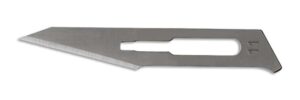
To open the aorta, surgeons use a scalpel with an 11-blade. This scalpel is used for operations and procedures on the aorta and heart. The blade of the scalpel should be sharpened to a fine point to cut into the arteries.
Some people are worried about the size of their body parts, including their eyes, hands, feet, and other parts of their bodies. This makes them nervous and self-conscious. It is natural to have some concerns about the size of certain parts of your body. There is no reason to feel bad about yourself if you are concerned about your body parts. It is important to remember that everybody has different body parts. It would be unfair to judge somebody based on their appearance.
12 Surgical blade
A No. 12 blade is a surgical tool that is used to make small cuts in certain areas. This is usually for incisions and/or for making small cuts around the nose and mouth. It is used by dentists, doctors, nurses and surgeons. A dentist uses this type of blade when he or she needs to make small cuts. For example, a dentist may need to make a cut to get rid of a small piece of tooth that has been damaged.

It is useful in several kinds of surgery. It is also used in some dental surgeries. A doctor will use a scalpel to make a surgical cut. Then, he will use this blade to finish the cut. The blade makes it easy to cut through the skin. When it comes to cutting the skin, there are two kinds of knives that doctors use. One is a scalpel. The other is a number 12 blade. This blade is sharper than a scalpel.
Blade #13 A small, pointed Blade with a straight edge.
A blade is a surgical instrument that cuts. Blades are often made of metal, but sometimes blades are made of plastic or ceramic materials. It is used to cut skin and muscle tissues during surgery. A blade has a curved cutting edge that is used to make small incisions in the skin.
It is used to open up blood vessels during surgery. Sometimes, blades are used to make holes in the abdomen during surgery. It is used to remove damaged or diseased tissue. This is usually done during abdominal surgery. Blades can also be used to cut skin and muscle tissue during surgery. The blade is pointed so that it can go deep into the body.
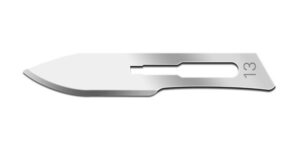
A blade has a curved cutting edge that is used to make small incisions in the skin. It is used to open up blood vessels during surgery. Sometimes, blades are used to make holes in the abdomen during surgery. It is used to remove damaged or diseased tissue. This is usually done during abdominal surgery. Blades can also be used to cut skin and muscle tissue during surgery. The blade is pointed so that it can go deep into the body.
Blade #14- Used to perform Dermabrasion
These are surgical knives used in an operating room. They are used for finer, delicate work.
This blade can be found on most operating tables. This is used for more delicate operations and for surgery of the face and neck.

They are used to perform dermabrasion, which is a surgical procedure used to refine the skin’s surface. Dermatologists use it to reduce wrinkles, blemishes, and blackheads. There are also many dermatologists who use this blade to remove hair from various parts of the body. They are also used to remove the hair from the eyelids and eyebrows.
15 surgical blade
15 blade is used to make an incision in the skin for various purposes. It is especially useful when it comes to performing cosmetic surgeries. For example, doctors may make an incision in the skin to remove a mole, scar tissue, or other skin growths.
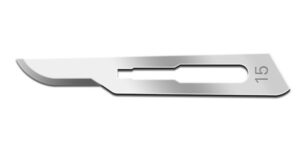
They may also make an incision in the skin for cosmetic reasons. Some people like to have plastic surgery done on their noses or lips. A doctor may perform this type of surgery to improve the appearance of your nose or to give you a new, more attractive look. In another procedure, the doctor may make an incision in the skin to create an opening into the sinuse
Blade #17
Surgical knife that has a curved edge. When choosing your knife, you should consider its size. A small, pointed knife is the best. The knife should be sharp and made from stainless steel. You should also ask if it is designed for delicate work.
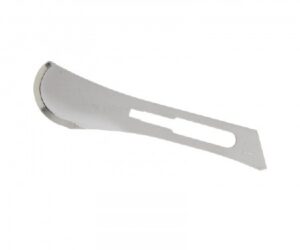
Blade #20- Large Curve on the Top Edge
This blade #20 has a large curve on the top edge, and is commonly used for cutting and piercing tissue and other body parts.
Most surgical blades are made out of stainless steel. They usually have a sharp tip. A surgeon uses a number of different surgical blades during the course of a day, depending on what he or she is doing. There are several types of surgical blades, including scalpel blades, small scissors, and scalpels.
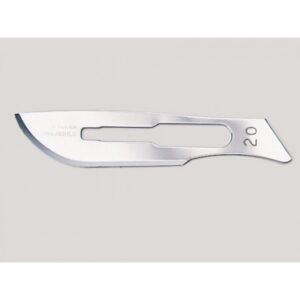
The scalpel blade is usually used to cut through the skin and to separate muscles. It is sharp enough to cut through skin and tissues easily.
A small pair of scissors is often used to trim skin and remove excess fat.A scalpels is usually used for deeper cuts.The blade used for orthopaedic surgery is made out of stainless steel and has a round tip.
Blade #21
This is similar to the #20, but has a large curved blade, commonly used for cutting tissue and other procedures that require a puncture or cut.
It is less likely to accidentally penetrate tissue or organs than the #20. Blade #22 This is a small knife with a thin, sharp point, and is used for making incisions, or small cuts, in skin and other tissues. The blade is about 3/16 inch wide. This type of knife is used mostly by surgeons. Blade #23 This is a surgical knife with a thin, straight, pointed tip. It is used to cut and dissect tissues. It is also used for skin incisions.

surgical blade 22
The No.22 surgical blade is a large version of the No.10 surgical blade with a curved cutting edge and a flat, unsharpened back edge. These blades are designed for skin incisions in both cardiac and thoracic surgeries.
In thoracic surgery, this blade is used to cut the bronchus in lung resection surgery. It is designed to cut through the pleura, making a long incision from the xyphoid process to the apex of the lung. This blade is a standard size, making it easy to find in a hospital. In addition, it is inexpensive and durable. This makes it a good choice for use in surgical incisions.
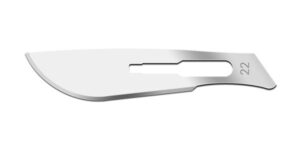
Incisions are used to make cuts in the skin so that surgeons can insert tools and devices into the body. When surgeons perform heart surgery, they will need to open up the chest and cut out part of the heart. During the procedure, the surgeon will make cuts in the skin so that he can insert tubes and tools into the body. The incisions in a heart surgery are made on the front and sides of the heart. The incision is usually placed above the breast bone and along the lower border of the rib cage.
surgical blade 23
If you want to make a cut into your skin, the no.23 blade is one of the best blades to use. It is ideal for making a small incision because it has a small diameter. In general, people use this blade for making small cuts. It is also known as a scalpel blade, but this is a bit of a misnomer. A scalpel can make deeper cuts.
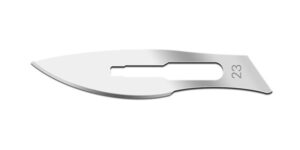
A scalpel has a longer and thinner blade and is designed to cut through tissue and bone. The smaller No.23 is designed to be used for superficial cuts. You can use the No.23 blade for small surgeries or for creating tiny incisions. To clean up your incisions after surgery, you should wipe them with a damp towel. Washing the wound helps to reduce the chance of infection.
pros
- very sharp
- Quality product
- inexpensive
- sterilized blades
cons
May be not good for delma planning

